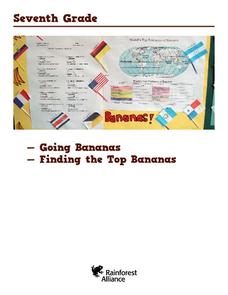Curated OER
Plants and Oxygen: Breathing
Second graders gain an understanding of how plants produce oxygen and that the oxygen we breathe comes from trees and plants. After a lecture/demo, 2nd graders discuss the ways plants produce oxygen and the detrimental effects of cutting...
Curated OER
What Are You Doing Here?
Students draw scenes of different environments and create unexpected visitors in those environments. They reinforce their understanding of the characteristics of different environments and the animals that do or do not live in these...
Curated OER
Tree Bagging
High schoolers bag trees to determine the mass of the water given off in the evapotranspiration process.
Curated OER
Mexican Independence Day
Pupils realize that countries have celebrations unique to them and demonstrate their understanding of the concept of tradition. They identify a family tradition that is important to each of them and demonstrate their understanding of the...
Curated OER
Animal Life Histories Derived From Morphology
Students learn the mechanisms of natural selection by deducing information from the physical appearance of the animal.
Curated OER
Earth Bags
Students discuss the environment and the problems facing our natural resources. They write ways to help the environment on paper grocery bags, illustrate them, and distribute them to grocery stores to be used with customers.
Curated OER
30 GOOD REASONS FOR TREES
Pupils create their own book of ideas about saving the environment. They research information the role of trees in the environment. Then make a large tree for a classroom bulletin board and put the leaves on the tree.
Curated OER
Mini-Ecosystems
Pupils use plastic bottles to create terrariums and plant Venus Flytraps. They observe the plants and the terrariums for illustrations of the water cycle and species' adaptations to a specific environment.
Curated OER
Endangered Species Field Trip
Learners use the internet to complete a virtual field trip on endangered species. They identify the causes of an animal becoming endangered or extinct. They practice using new vocabulary as well.
Curated OER
30 Good Reasons for Trees
Students create their own book about the role of trees in the environment. They are to come up with a list of 30 reasons they benefit the environment. They hold a publication party to release their book.
Curated OER
How To Save The Planet
Students work together in groups to create a book about how to save the environment. They are to research ways to help the environment and assemble them into the book. They can even design a cover if they choose.
Curated OER
What are You Doing Here?
Students discuss different types of environments and climates on Earth. They choose an environment and draw a picture of it, another student create an animal that he/she believes belongs in that particular environment.
Curated OER
Environmental Science/Water Pollution
Young scholars study natural habitats, aquatic life, renewable and non-renewable resources. They discuss conservation efforts for sea otters and desert toad in this units.
Curated OER
Rapid Mycological Assessment
Students examine types of mycology methods. They practice using new vocabulary and answer key questions. They complete a field survey and analyze their results.
Curated OER
Ecosystems Online
Learners work together to gather information on ecosystems from websites. They identify plants and animals and create their own website. They are graded on their willingness to work together and the content on the website.
Curated OER
The Bite of The Caiman
Learners study about Caimans-large reptiles that live in Manu. They create a model of the bite of the caiman in a class activity. They calculate the length of the caiman from the size of the model bite.
Curated OER
Honduras: Going Bananas
Students explore the popularity of bananas. They conduct a survey to understand the reasons for their popularity. Students research a banana's journey from the farm to school lunch. They compose a children's book about bananas explaining...
Curated OER
Commercial Uses of the Rainforest
Students go on a scanvenger hunt to find products (from a provided worksheet) that have ingredients that come from the rainforest. They then decide if the products are really needed by consumers and make a display of them.
Curated OER
Snacks in a Bag
Learners brainstorm a list of their favorite snacks. Using clues, they identify the type of snack being described. On a map, they identify and locate the origin of the ingredients used to make it. They write their own clues for...
Curated OER
One Square Meter
Learners examine various ecosystems using scientific inquiry. Using the local area, they assess the characteristics and conditions in one square meter. They report their findings in the form of a survey map and data sheet. They...
Curated OER
Bat Habitat
Ninth graders engage in a lesson to find the role of bats in the complexity of certain ecosystems. They identify where bats live and the daily role played in the ecosystem. Students also construct a bat house to help control the...
Curated OER
Biome Exchange: Send the Stuff Not The Kids
Students exchange information with students from various geographic biomes. They explore the unique ecologically significant features of the biomes and share with other students.
Curated OER
Active Ingredient Screening Test for Plants
Students explore the growth of bacteria. They determine if various plant materials contain active ingredients that inhibit the growth of bacteria. In addition, they complete a student data sheet.
Curated OER
Active Ingredient Screening Test for Plants
Young scholars determine if various plant materials contain active ingredients which will inhibit the growth of bacteria. They identify plant materials and their degree of sensitivity.
Other popular searches
- Rainforests Art
- Rain Forest Diorama
- Rain Forest Energy Pyramid
- Tropical Rain Forest
- ( Rainforest | Rain Forest)
- Rain Forest Food Webs
- Rain Forest Deforestation
- Rain Forest Worksheet
- Tropical Rainforests
- Brazil Rain Forest
- Rain Forest Insects
- Geography Rainforests

























